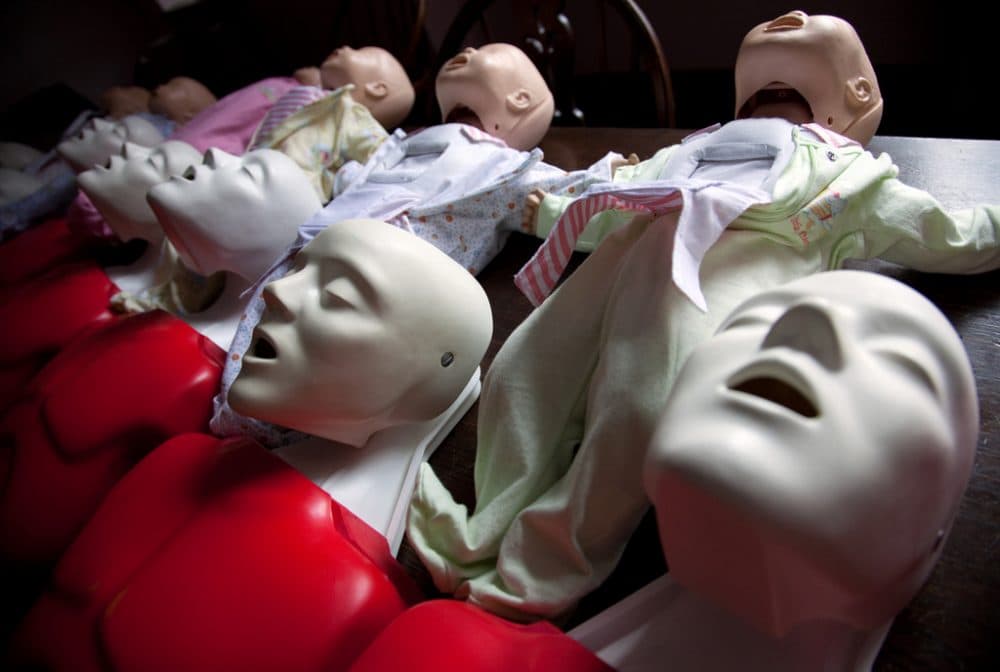Advertisement
Most States Don't Require CPR Training For High Schoolers — Should They?

By Marina Renton
CommonHealth intern
I walked into health class one day to find slack-jawed mannequin heads atop foam torsos lined up in rows on the classroom floor. Interspersed among the adult mannequins were infant dummies -- fully formed, but equally eerie.
That macabre scene began the first aid unit of 11th-grade health, which included the memorable experience of giving the mannequins chest compressions to the rhythm of “Stayin’ Alive,” using both hands for the adults and only two fingers for the infants.
I learned cardiopulmonary resuscitation at a Massachusetts public high school, but it wasn’t a legally mandated part of the curriculum. Twenty-one states — including Washington, Texas, Alabama and Iowa — have passed laws that make CPR training a high school graduation requirement. Massachusetts is not one of them.
Someone 'has to take up the torch and really advocate for it.'
Dr. Farrah Mateen
But maybe it should be. A commentary just out in the Mayo Clinic Proceedings argues that the potential benefits of requiring CPR training in high school — from saving lives to getting a taste of selfless service — are so great that every state should do it.
Why don’t they? The answer isn’t that states are necessarily facing resistance to the laws. It’s that the laws just aren’t a priority, says commentary co-author Dr. Farrah Mateen, an assistant professor of neurology at Harvard Medical School and a neurologist at Massachusetts General Hospital.
In other states, legislation has been advanced by champions of the cause, Mateen said.
Students, survivors of cardiac arrest, bystanders who worked to resuscitate someone and family members of victims of cardiac arrest who didn’t survive have all become active in promoting high school CPR training.
Someone has to “take up the torch and really advocate for it,” said Mateen, who wrote the commentary with Tali Sorets, a former high school intern at Mass. General.
Why Learn CPR?
The commentary notes that over 1,000 people each day go into cardiac arrest while not in hospitals, which makes bystander intervention critical to the victims’ survival. Training in CPR is the leading factor influencing whether a bystander intervenes, the commentary authors say, citing a 2006 study.
With cardiovascular disease the leading cause of death in the United States, today’s high school students are likely to be impacted either directly or indirectly by it, Mateen said, and mandatory CPR training might serve to mitigate existing health disparities.
Poverty and cardiovascular disease “often track together,” but poorer school districts might be less likely to invest in CPR training programs, she said.
Also, rates of cardiac arrest survival vary geographically, from as low as 0 percent in some cities, to over 40 percent in others, a “really substantial” [disparity].
The good news? “That [disparity] can be mediated pretty cheaply and quickly,” perhaps aided by legislation, Mateen said. “Could legislation fix this? I think mostly yes.”
The American Heart Association — a leading organization in CPR training — estimates that more than 1 million students receive training each year as a result of existing legislation.
The commentary authors write that not all legally required high school CPR training programs are created equal. They can include videos, training in mouth-to-mouth resuscitation, training in chest compression-only CPR (recommended by the heart association for use on adults and teens who experience cardiac arrest) and training in automated external defibrillator use, Mateen said.
Defibrillator training is a “major incremental benefit,” but beyond that there isn’t any decisive evidence that certain levels of high school CPR training yield better results, she added. Research does indicate that “people who are trained are more likely to choose to act.”
Those who are trained may also learn a civic lesson. Many recommended health behaviors — wearing a seatbelt, getting vaccinated — involve at least some self-interest. In contrast, CPR training is selfless, the authors note in the commentary.
“Doing something that’s solely for someone else shows you something about society, that not everything we do is for ourselves,” Mateen said in an interview. “I think that’s important.”
Learning CPR might inspire students to enter into health professions, she added.
What Is To Be Done?
Even if CPR training isn’t offered at school, there are other means of receiving training. Organizations like the American Heart Association and the American Red Cross offer online and in-person training; the online courses at both organizations cost less than $30.
Many people are required to be trained in CPR for their jobs, Mateen noted, especially those in health care professions. The American Heart Association’s CPR in Schools program sells kits designed for classroom training.
My health class CPR training left a strong impression, but the commentary suggests that more research and analysis are needed to measure whether high school training has lasting effects and whether certain curricula are more effective than others.
The full commentary is available here. Readers, thoughts? Should CPR be a requirement to graduate high school?